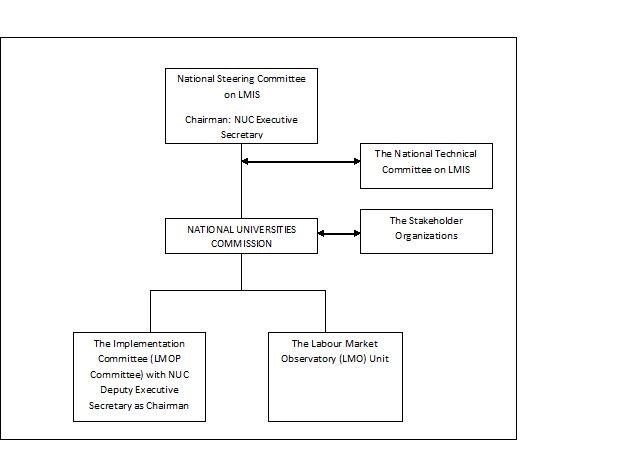Introduction
In recent years, there has been widespread concern among stakeholders over the quality of graduates from Nigerian Universities which calls to question the currency of the curricula of academic programmes being taught in the Nigerian University system and their relevance to current and future demands of the Nigerian Society.
The lack of a regular study to advise the Nigerian University System on the graduate needs of the labour market has led to a mismatch with competencies of university products. This needs to be urgently addressed. Consequently, the quality and focus of the training offered by the universities are not in tune with the needs of the society and this has led to high unemployment as many of the graduates are perceived to be unemployable, especially in the science and technology disciplines.
In collaboration with other stakeholders, the NUC is coordinating the establishment of a functional Labour Market Information System (LMIS) which will provide the needed guidance and basis for determining the courses, programmes and number of graduates required by the economy. The LMIS will also serve as a feedback mechanism to guide curriculum review in the universities.
Objectives:
The objectives of the Labour Market Observatory Project are:
- To create among stakeholders awareness of LMI, its benefit and the need for a coordinated Nigeria labour market information system;
- To recruit commitment of the relevant public and private authorities to providing policy support for the Labour Market Observatory Project and the Nigeria Labour market information system;
- To elicit collaboration of stakeholder agencies and organisations in the implementation of the Nigeria Labour Market Information System (LMIS).
- To identify labour market information needs of stakeholders;
- To develop key labour market indicators based on identified LMI needs of stakeholders;
- To develop a comprehensive labour market information system in collaboration with planners, producers and users of LMI;
- To regularly collect, process, store, analyse, use, share and disseminate labour market data and information among stakeholders especially in the Nigerian economy;
- To guide national policy and programme development on labour market issues; e.g. national decisions on higher education programmes;
- To put in place structures at national level for LMIS policy and at institutional level for management of the Nigeria LMIS on a sustainable basis; and
- To identify skill gaps among LMIS desk officers and on this basis, conduct targeted training to build their capacity for effective participation in the LMOP and the Nigeria LMIS.
The organogram for the governance structure of the LMOP and national LMIS is shown below.
Computerised Labour Market Information Sysytem (COLMIS)
The NUC procured labour market information system software named Computerised Labour Market Information System (COLMIS) for use by the LMOP in its pilot LMI survey of the manufacturing sector and subsequently by the LMO in the larger LMIS survey covering all sectors of the Nigerian economy.
COLMIS is web-based software that was designed to assist in the creation of questionnaires, input of questionnaire responses into the database, generation of general reports, management of stakeholder and respondent data for any labour market study. COLMIS is hosted on an AIX server (IBM) server within the NUC and can only be assessed internally based on specific permissions.
The key functions and capability of COLMIS are as follows:
- Manage Sectors and subsectors:
- Create Sectors
- Create subsectors
- Link subsectors with sectors
- Manage participating organization details:
- Add participant details
- Update participant details
- Delete participant
- View participant details
- Manage Questionnaires:
- Create questionnaires
- Search questionnaires
- Print questionnaires
- Manage Data:
- Input data from completed questionnaire.
- Process data from data inputted.
- Generate tables/reports
- Manage application users:
- Add users
- Delete users
- Update users
Documents on Pilot Study on Manufacturing Sector
LMOP Stakeholders in Manufacturing Sector
LMOP Report on Manufacturing Sector

